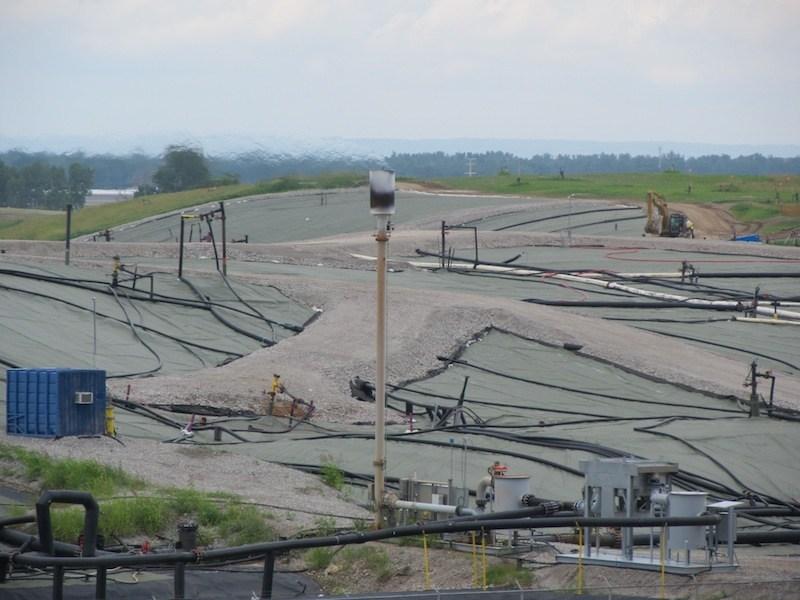
A fire has been slowly burning underneath a landfill in the St. Louis, Missouri, area for five years. The Bridgeton Landfill, part of the West Lake Landfill, is less than a quarter of a mile away from 8,700 tons of radioactive barium sulfate.
This nuclear waste is left over from the federal government’s Manhattan Project, a program that developed nuclear weapons (think: Hiroshima and Nagasaki). According to the Missouri Coalition for the Environment (MCFE), the waste was “illegally dumped” at the landfill in 1973.
Last weekend, an above-ground fire occurred at the landfill: On Oct. 24, the Bridgeton Landfill notified the Missouri Department of Natural Resources of a small grass fire. Although the fire was contained and distinguished, it highlights the problems that exist at the landfill. In 1990, it was listed on the EPA's National Priorities list, which makes it a superfund site.
The EPA does not seem very concerned despite the fact that the landfill is near nuclear waste deposits. In an assessment released on Oct. 16, the federal agency acknowledged that the “surrounding community is concerned that the fire will reach the radioactive waste areas leading to additional contamination in the air and groundwater.” However, the EPA’s assessment concluded that the level of outdoor radon, a radioactive gas produced from nuclear waste, is “well below radon concentrations associated with elevated lung cancer risks.” The assessment also dismissed concerns about groundwater contamination.
Missouri Attorney General Chris Koster is fighting a legal battle to get the landfill site cleaned up. He even filed a lawsuit against the landfill’s owner, Republic Services.
In September, Koster released a report from expert witnesses in the case. The testimonies regarding the underground fire include one from Drs. Joel Burken and Shoaib Usman, professors of environmental and nuclear engineering at Missouri University of Science and Technology. Burken and Usman detected both radiological and organic contamination in trees on the property of landowners near the landfill. The report states that their findings “indicate the off-site migration of RIM [radiologically impacted material], either in groundwater or aerial transport of particulate matter.”
After the recent grass fire, Koster released a statement. While the attorney general expressed relief that the EPA’s “studies do not show an immediate danger to the general public,” he pointed out that the grass fire “reminds us, flames can surface in unexpected places without warning.” Koster recommended that the EPA move “toward a final protective remedy ... without delay.”
Local officials are concerned about a possible emergency situation occurring because of the situation at the landfill. Last year, St. Louis County created an emergency operations plan, which acknowledged that there is a “sub-surface smoldering event” that has been occurring for “several years” at the landfill. The plan states that if the so-called event “reaches the radiological area, there is a potential for radioactive fallout to be released in the smoke plume and spread throughout the region.”
The emergency operations plan also acknowledges that the release of radioactive fallout “will most likely occur with little or no warning.” For that reason, the plan was created to create “guidelines for conducting efficient, effective, coordinated emergency operations involving the use of all resources.” In other words, the county is not waiting around to plan for the worst-case scenario.
So, what can and should be done to prevent the worst-case scenario of radioactive fallout? The MCFE suggests a number of things, including that the St. Louis Army Corps of Engineers “be put in charge right now” because the corps has “the technical expertise and track record for the safe cleanup of radioactively contaminated sites.” The MCFE also suggests that the radioactive waste be safely removed from the landfill to avoid the “constant threat” they pose.
It remains to be seen whether the MCFE’s recommendations will be acted on. For the sake of the people in the St. Louis area, we can only hope so.
Image credit: Wikimedia Commons

Gina-Marie is a freelance writer and journalist armed with a degree in journalism, and a passion for social justice, including the environment and sustainability. She writes for various websites, and has made the 75+ Environmentalists to Follow list by Mashable.com.














